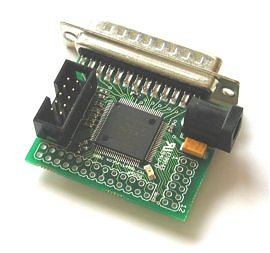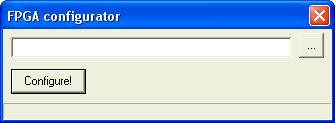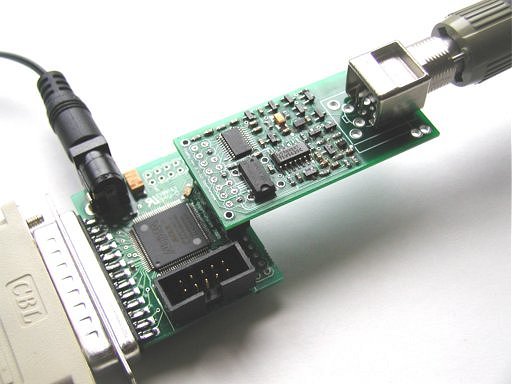

Pluto-P FPGA board
Pluto-P is an FPGA board that plugs into a PC (desktop or notebook) parallel port.

Pluto-P has the following characteristics:
- Based on Altera's EP1K10TC100 FPGA - see Altera ACEX device family.
- Connects to your PC's parallel port (use a parallel extension cable if you don't want to plug Pluto-P directly to the back of your PC).
- Can communicate with the PC in SPP or EPP mode (source code provided).
- 28+3 I/O pins available (the '+3' are one clock and two dedicated inputs). The IOs are 3.3V, but 5V tolerant - great to connect to legacy systems.
- JTAG output port.
- Flashy compatible (100MSPS acquisition board).
- Community supported EMC2 CNC project.
FPGA configuration
Pluto-P comes with an application to configure the FPGA.

Select the bitfile you want, and click the "Configure!" button.
The FPGA is configured through the parallel port. The process takes 1 to 2 seconds.
Pluto-P in FPGA mode
To use Pluto-P as a regular FPGA board:
- Plug Pluto-P in the back of your notebook (or desktop) PC.
- Power it using a common DC adapter.
Pluto-P's FPGA is configured through the parallel port. After configuration, Pluto-P can still communicate with the PC through the parallel port. See for example fpga4fun's EPP bi-directional mode project, and the Flashy oscilloscope (below).
Pluto-P has a built-in voltage regulator, so that you can use a cheap DC adapter (5V to 12V) as power.
Pluto-P in "JTAG cable" mode
Pluto-P can be used as a JTAG cable (it emulates such cable, so that it can configure an FPGA on another board for example).
Here's how it works:
- Plug Pluto-P in the back of your notebook (or desktop) PC.
- Connect its JTAG port into another FPGA board (Pluto-P borrows power from its host JTAG board. No need for a DC adapter, but needs to be 3.3V JTAG port).
- Configure Pluto's FPGA with one of the provided JTAG cable bitfile. Now Pluto-P emulates an Altera ByteBlaster II or a Xilinx Parallel III JTAG cable. Just use Xilinx ISE Impact, or Altera Quartus-II programmer, as you would with any FPGA cable.

Flashy
Pluto-P is compatible with the Flashy boards.

The combination creates a single channel 100MSPS acquisition board/digital oscilloscope.
Pluto-P/Flashy reference design uses EPP. So if you order Pluto-P and Flashy, make sure that your PC supports EPP.
What files are provided with Pluto-P?
Board files:
- Getting started with your board (PDF)
- FPGAconf configuration software (Windows EXE)
FPGA:
- SPP & EPP examples (HDL + C source code)
- Flashy reference design (FPGA RBF file + GUI)
- JTAG Xilinx & Altera emulation files (FPGA RBF file)
To purchase a board
Go to the Shop - FPGA development boards page.